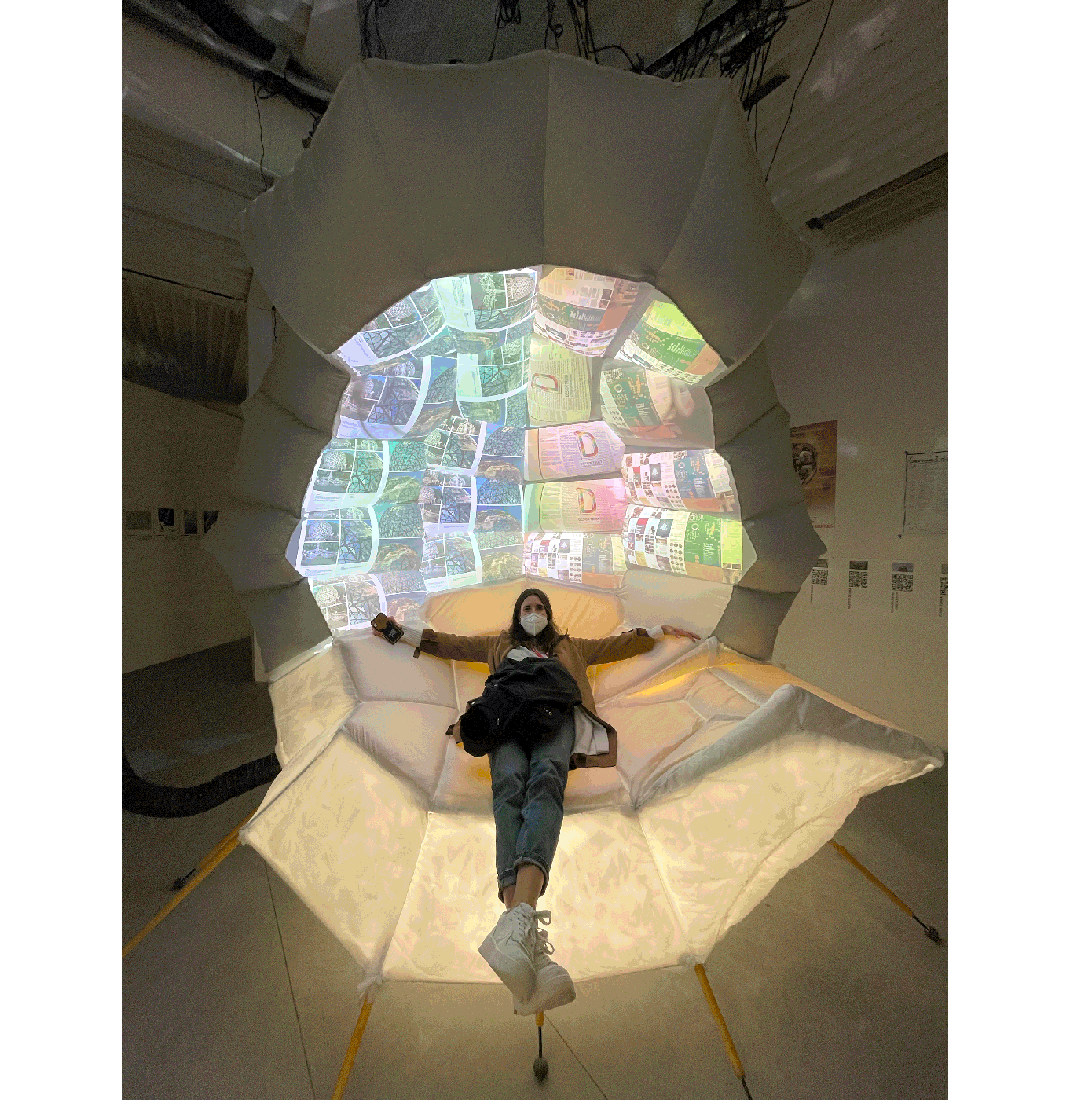GEOSCOPE 2
May 22–November 21, 2021
R. Buckminster Fuller’s iconic Geoscopes are rethought through a contemporary lens.
View photos here.
Now through November 21, 2021, Geoscope 2, a split-sphere, multi-media installation, appears at the 2021 Venice Architecture Biennale, showcasing over a dozen (and counting) contemporary voices inside and outside architecture, ranging from Pritzker Prize–winning architect Kazuyo Sejima to radical ecologist and philosopher Timothy Morton.
Inspired by Daniel López-Pérez’s provocative and luminous book R. Buckminster Fuller: Pattern Thinking (Lars Müller Publishers, 2020), architect Jesse Reiser and team were challenged with displaying the breadth and quality of its content for an exhibition at Princeton University School of Architecture in February 2020. The result was a first iteration of Geoscope 2: a pneumatic, spherical multimedia environment and continuation of Fuller’s original geoscopes, reimagined through contemporary means. A year later, the School of Architecture is thrilled to see the second iteration on view at the 17th International Venice Architecture Biennale.
The first geoscopes, constructed by students of R. Buckminster Fuller (1895–1983) 60 years ago, were conceived as “embodiments of the world looking at itself,” and a means of comprehensively understanding one’s relationship to the world. In response to the Biennale’s question “How will we live together?” Geoscope 2 flouts the idea of a single world body in favor of “many worlds”—chaos generated by multiple bodies interacting with each other—by literally splitting the sphere in half and opening it up to multiple contributors and perspectives.
“Fuller’s Geoscopes, while conceptually ambitious, were technologically limited by their times: literally analog vinyl spheres covered in decals in the shapes of the continents,” note López Pérez and Reiser. “The way we see it, new technologies and advances in how we view the world have allowed us to simultaneously reimagine and challenge Fuller’s original project. We believe that disunity, disjunction, and dissensus—‘worlds’—are to be celebrated as evidence of true diversity in how we think, act, and interact with one another. This is our critical take on how will we live together: spirited agon as opposed to polite relativism.”
Visitors to the installation at the Central Pavilion in the Giardini will find themselves enveloped in a panoramic multimedia experience projected over 42 individual faces. Comprised of an international cast of contributors, Geoscope 2: Worlds generates a complex, kaleidoscopic ecosystem, a tableaux of world-thinking on the edge.
Daniel López-Pérez (Madrid, 1973) holds a PhD in the history and theory of architecture from Princeton University, and is an associate professor and founding faculty member of the Architecture Program at the University of San Diego. López-Pérez is the author of R. Buckminster Fuller, Pattern-Thinking (Lars Muller Publishers, 2020) and editor of Fuller in Mexico (Arquine, 2015) and R. Buckminster Fuller, World-Man (Princeton University Press, 2013) awarded Design Book of the Year 2013 by Architecture magazine.
Reiser + Umemoto, RUR Architecture, is a New York-based, internationally recognized architecture firm operating at a wide range of scales and contexts. In 2010, the firm was awarded first prize for the Taipei Music Center and the Kaohsiung Port Terminal in Taiwan, both set to be completed in 2021. Central to the firm’s ethos is the reciprocity between building theory and building buildings. The firm’s Atlas of Novel Tectonics (2006) initiated new materialist approaches in architecture and quickly became a touchstone in the discipline. The firm’s first comprehensive monograph, Projects and Their Consequences, was published in 2019.
Jesse Reiser (New York, b. 1958) is a registered architect in New York, principal of Reiser + Umemoto, RUR Architecture, and Professor of Architecture at Princeton University. He is a fellow of the American Academy in Rome in 1985, previously having worked in the offices of John Hejduk and Aldo Rossi.
Nanako Umemoto (Kyoto) is a principal of Reiser + Umemoto, RUR Architecture. Nanako has lectured widely at various educational and cultural institutions throughout the United States, Europe and Asia, including Harvard University, the University of Pennsylvania, Columbia University, EPFL in Lausanne Switzerland, Hong Kong University, Kyoto University, and Cooper Union.
Team:
Daniel López-Pérez & Jesse Reiser
Geoscope 2 Design: RUR Architecture, Reiser+Umemoto
RUR Architecture Team: Julian Harake, Katherine Leung
Inflatable Design: Pablo Kobayashi / Unidad de Protocolos
Inflatable Fabrication Team: Lucía Aumann, Ernesto Falabella, Emilio Robles, Pablo Kobayashi / Unidad de Protocolos
Experience Design: Jan Pistor - Bureau 314 / for iart, with support from Denim Szram
Exhibition Manager: Kira McDonald / Princeton University School of Architecture
Exhibition Fabrication Assistants: Jasen Domanico, Kaleb Houston, Simon Lesina-Debiasi, Matthew Maldonado, Jacqueline Mix, Sonia Sobrino Ralston, Adrian Silva / Princeton University School of Architecture
Partnerships & Communications: Lukas Fitze / iart
Trailer Video: Onome Ekeh / Futurezoo
Additional team from R. Buckminster Fuller: Pattern Thinking, 2020:
Fabrication Lead: Grey Wartinger / Princeton University School of Architecture
Exhibition Assistants: Andrew Cornelis, Ryan Gagnebin, Matthew Maldonado, Elena M’Bouroukounda, Jacqueline Mix, Sonia Sobrino Ralston, Felix Yiu / Princeton University School of Architecture
Contributors:
Marisa Yiu, Satyan Devadoss, Karl Chu, Ulrika Karlsson, Pablo Kobayashi, Urtzi Grau, AKT II, Cal Fires Technosylva, Nerea Calvillo, Ciro Najle, Reiser + Umemoto (with Julian Harake, Zaid Kashef Alghata and Yumi Chu), Tyler Armstrong, Elena M’Bouroukounda, Luis Muñoz, Daniel López-Pérez, Alejandro Zaera-Polo, Timothy Morton, David Ruy, Forensic Architecture, Stan Allen, Jeffrey Kipnis, Kazuyo Sejima, Erhard An-He Kinzelbach, Elisa Iturbe
More info.

